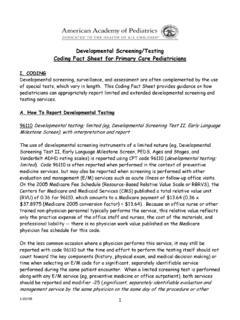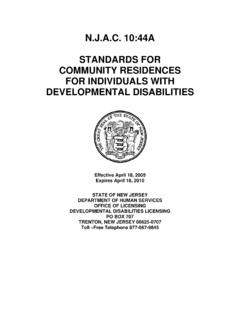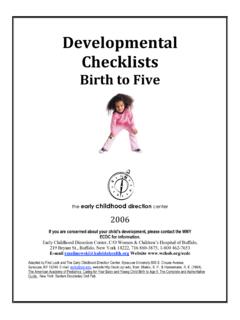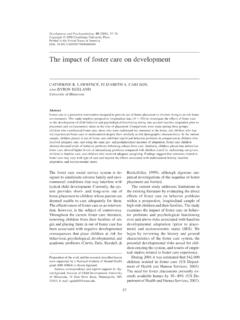Transcription of Vygotskian and Post-Vygotskian Views on Children’s Play - ed
1 Vygotskian and Post-Vygotskian Views on Children's Play . Elena Bodrova Deborah J. Leong The authors argue that childhood played a special role in the cultural-historical theory of human culture and biosocial development made famous by Soviet psy- chologist Lev S. Vygotsky and his circle. They discuss how this school of thought has, in turn, influenced contemporary play studies. Vygotsky used early childhood to test and refine his basic principles. He considered the make-believe play of pre- schoolers and kindergartners the means by which they overcame the impulsiveness of toddlers to develop the intentional behavior essential to higher mental functions. The authors explore the theory of play developed by Vygotsky's colleague Daniel Elkonin based on these basic principlies, as well as the implications for play in the work of such Vygotskians as Alexei Leontiv, Alexander Luria, and others, and how their work has been extended by more recent research.
2 The authors also discuss the role of play in creating the Vygotsky school's zone of proximal development.. Like these researchers, old and new, the authors point to the need to teach young children how to play, but they caution teachers to allow play to remain a childhood activity instead of making it a lesson plan. Key words: childhood devlopment;. cultural-historical psychology; Lev S. Vygotsky; preschool play; zone of proximal development A well-known, often-quoted passage from Russian psychiatrist Lev S. Vygotsky states: In play a child is always above his average age, above his daily behavior; in play it is as though he were a head taller than himself. As in the focus of a magnifying glass, play contains all developmental tendencies in a condensed form; in play it is as though the child were trying to jump above the level of his normal behavior (1967, 16).
3 These lines, which come from a 1933 lecture on play, have recently regained the attention of scholars and practitioners. Interestingly, the interpretations of this paragraph can differ dramatically depending on the philosophical orienta- tion of the interpreter. For example, some present it as an injunction for adults not to interfere in children's play, because more than any other activity play seems to allow a young child to jump above the level of his normal behavior.. 371. American Journal of Play, volume 7, number 3 The Strong. Contact Elena Bodrova at Excerpted from The Handbook of Play Studies, copublished by The Strong and Rowman & Littlefield. 2015 by Rowman and Littlefield.
4 All rights reserved. 372 AMERICAN JOURNAL OF P L AY SPRING 2015. Others find in these very same words from Vygotsky a call to use play as an efficient vehicle to deliver academic concepts and skills to preschoolers and kindergartners. Both interpretations, however, are inconsistent with the way Vygotsky and his students regard play, which is known as the cultural-historical approach. Our purpose in this article is to help the reader understand when and how Vygotsky's theory of play was developed and later built upon by his students and what this theory may mean for the contemporary study of play. Vygotsky on Play: The Blueprint of a Theory To understand fully Vygotsky's Views on play, we need to place them in the larger context of Vygotsky's theory of human development and learning as well as in the broader cultural and historical context in which he and his students devel- oped their approach to play.
5 Vygotsky's scientific biography covers a short span of ten years from 1924 to1934, during which he produced a number of works now considered definitive in fields ranging from special education to art studies to psycholinguistics. The field of child development, however, occupies a special place in Vygotsky's scientific legacy. It was in the context of child development that Vygotsky discussed many of his well-known ideas, such as the zone of proxi- mal development (the law of the development of higher mental functions) and the notion of instruction preceding and shaping development. Indeed, his theory of children's play cannot be separated from these broader theoretical constructs.
6 Vygotsky's interest in play appeared evident from his early works published in the 1920s, such as The Psychology of Art (1971) and The Prehistory of the Development of Written Language (1997b), but he expressed his main ideas about play in the 1933 lecture from which we have already quoted, Play and Its Role in the Mental Development of the Child (1967). This lecture that can rightly be considered the blueprint for the theories of play developed in the cultural-historical tradition. At its core, Vygotsky's cultural-historical theory considers the history of human development to be a complex interplay between the processes of natural, biologically determined development and the cultural development created by the interaction of a growing individual with other people.
7 The result of these interactions proves more than the simple acquisition of the values, expectations, and competencies promoted by a specific culture. Rather, the entire system of naturally determined ( lower ) mental functions, such as involuntary attention, Vygotskian and Post-Vygotskian Views on Children's Play 373. rote memory, and sensory-motor thought, becomes restructured to produce what Vygotsky described as higher mental functions: When the child enters into culture, he not only takes something from culture, assimilates something, takes something from outside, but culture itself profoundly refines the natural state of behavior of the child and alters completely anew the whole course of his development (1997a, 223).
8 Vygotsky defined higher mental functions as behaviors that are sign- mediated, intentional, and internalized, and he described their development as a gradual process involving the transition from interindividual ( intermen- tal ) or shared to individual ( intramental ). For young children, most of the higher mental functions still exist only in their interindividual form as they share these functions with adults or with other children: Every function in the cultural development of the child appears on the stage twice, in two planes, first, the social, then the psychological, first between people as an inter' mental category, then within the child as intra' mental category. This pertains equally to voluntary attention, to logical memory, to the formation of concepts, and to the development of will (1997b, 106).
9 Vygotsky's Views on the development of higher mental functions reflect his attempt to resolve what he described as the crisis in psychology (1997a). Vygotsky believed that psychology was a discipline torn between those who advocated objective methods equally applicable to lower mental functions in both humans and animals and those who focused exclusively on uniquely human higher mental functions accessible only through introspection. Subscribing to neither of these two schools of thought, Vygotsky suggested a new approach that focused on the origins and development of higher mental functions both in phylogeny and in ontogeny. Although the phylogenetic pro- cesses (species development) can only be inferred based on cultural artifacts produced at different stages of the evolution of humankind, the ontogenesis (individual development) of higher mental functions can be accessible to direct observation as well as to empirical investigation.
10 Thus, for Vygotsky, child development and learning means more than a source of practical examples for his cultural-historical theory. Instead, they were the subjects he and his students could use to test and refine the basic principles of this theory. Early childhood for Vygotsky was the period during which the restructuring of lower mental functions goes through its initial stages as children for the first time in their lives used cultural tools to transform their cognitive processes such as perception, attention, memory, and thinking. Social-emotional 374 AMERICAN JOURNAL OF P L AY SPRING 2015. capacities are similarly transformed, allowing children to make a transition from being slaves to the environment to becoming masters of their own behavior.


















